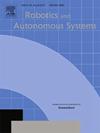Reinforcement learning-based optimal formation control of multiple robotic rollers in cooperative rolling compaction
IF 4.3
2区 计算机科学
Q1 AUTOMATION & CONTROL SYSTEMS
引用次数: 0
Abstract
For the sake of enhancing the rolling compaction quality and operation efficiency in infrastructure construction, this paper addresses the issue of optimal formation control for cooperative rolling compaction of a group of robotic rollers (RRs) by a combination of the reinforcement learning (RL)-based tracking control technique and the virtual structure method. The RR’s kinematic model is first established by fully considering the structural characteristics of the active revolute joint. Via the kinematic model and the virtual structure method, formation control of multiple RRs is formulated as path-following control with respect to their corresponding node in the desired rolling compaction formation shape. Then, optimal formation control policies of RRs are derived by the value functional that is the solution to tracking Hamilton–Jacobi-Bellman equation. By resorting to the RL-based tracking control, approximate optimal control policies are obtained by forward-in-time online neural network estimation of the value functional. Locally uniform ultimate boundedness of the closed-loop formation error system is analyzed rigorously by the Lyapunov technique. Finally, numerical simulation results are presented for three-RR cooperative rolling compaction of a clay core wall dam in Qianping reservoir to show the effectiveness of the main results of this paper.
基于强化学习的多机器人辊子协同压实最优编队控制
为了提高基础设施建设中的碾压质量和作业效率,将基于强化学习(RL)的跟踪控制技术与虚拟结构方法相结合,研究了一组机器人碾压机协同碾压的最优编队控制问题。在充分考虑主动旋转关节结构特点的基础上,首先建立了主动旋转关节的运动学模型。通过运动学模型和虚拟结构方法,将多个RRs的编队控制表述为对其对应节点的路径跟随控制。然后,通过求解跟踪Hamilton-Jacobi-Bellman方程的值泛函,推导出最优的rs编队控制策略。采用基于rl的跟踪控制,通过在线前向神经网络对值泛函进行估计,得到近似最优控制策略。用李雅普诺夫技术对闭环编队误差系统的局部一致极限有界性进行了严密的分析。最后,给出了前坪水库粘土心墙坝3 - rr协同碾压压实的数值模拟结果,验证了本文主要结果的有效性。
本文章由计算机程序翻译,如有差异,请以英文原文为准。
求助全文
约1分钟内获得全文
求助全文
来源期刊

Robotics and Autonomous Systems
工程技术-机器人学
CiteScore
9.00
自引率
7.00%
发文量
164
审稿时长
4.5 months
期刊介绍:
Robotics and Autonomous Systems will carry articles describing fundamental developments in the field of robotics, with special emphasis on autonomous systems. An important goal of this journal is to extend the state of the art in both symbolic and sensory based robot control and learning in the context of autonomous systems.
Robotics and Autonomous Systems will carry articles on the theoretical, computational and experimental aspects of autonomous systems, or modules of such systems.
 求助内容:
求助内容: 应助结果提醒方式:
应助结果提醒方式:


